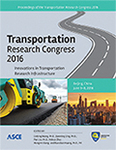Transportation Research Congress 2016
Stratigraphic Classification Based on the Evaluated Difficulty of the Construction by Using Shield Tunneling Machine
Publication: Transportation Research Congress 2016: Innovations in Transportation Research Infrastructure
ABSTRACT
There are diverse stratigraphic classifications in tunneling, which played a vital role in engineering practice. Current rock classifications were basically developed for mining method tunnel where the ground stability was the main evaluation index. However, in shield tunneling, we paid more attention to the boreability of strata, the wear of cutters, the stability of heading face, as well as the ground movement. What’s more, the current classifications failed to take the complex strata into account, but this factor might have the major impact on shield tunneling, and sometimes even played the decisive role. So the ordinary classifications had certain limitations when were applied in shield tunneling. In order to classify the strata based on the difficulty of shield tunneling, four evaluation factors were selected, including drivage efficiency, cutter wear, heading face stability, as well as ground loss and displacement. According to the difficulty of cutting and deformation control, the ground was divided into four categories, including easy to cut and easy to control, easy to cut and hard to control, hard to cut and easy to control, hard to cut and hard to control as well, and corresponding suggestions for each category were put forward in the end. This stratigraphic classification can make up for the limitations of the current classification and provide practical references for control measures in shield tunneling.
Get full access to this article
View all available purchase options and get full access to this chapter.
REFERENCES
Barton, N., Lien, R., & Lunde, J. (1974). “Engineering classification of rock masses for the design of tunnel support.” Rock Mechanics, 6(4), 189-236.
Barton, N. (1999). “TBM performance in rock using QTBM.” Tunnels and Tunneling.1999, 31:41-48.
Bieniawski, Z. T. (1974). “Engineering classification of jointed rock masses.” discussions of paper by ZT Bieniawski, trans. s. afr. instn. civ. engrs. v15, n12, Dec. 1973, and authors reply: 4F, 4T, 39R. Trans. S. Afr. Instn. Civ. Engrs. V16, N7, July, 1974, 239-254.
Deere, D. U., (1964). “Technical description of rocks for engineering purposes.” Rock Mechanics and Engineering Geology 1, 237-303.
He, F. L., Gu, M. C., Wang, S. C. (2002) “Study on surrounding rock mass classification of tunneling cut by TBM”. Chinese Journal of Rock Mechanics and Engineering. 2002, 21:(9)1350-1354.
Liao, H. Y. (2012) “Technology for Shield Tunnel Mixed Face Ground Conditions—Study and Practice in Shield Tunneling Projects of Guangzhou Metro.” Chnia Building Industry Press. Beijing.
Liao, S. M., Liu, J. H., Wang, R. L., & Li, Z. M. (2009). “Shield tunneling and environment protection in Shanghai soft ground”. Tunnelling and Underground Space Technology, 24(4), 454-465.
Li, C., Peng, R. Y. (2006). “Discussion on the classification method of surrounding rock of TBM construction tunnel.” Domestic and foreign road, 26(3), 235-237.
Peck, R. B. (1969). “Deep excavations and tunneling in soft ground.” 7th Int.Conf. Soil Mech. Fdn. Engrg, Mexico City, Sociedad Mexicana de Mecanica de Suelos, A.C.
Pinto, F., & Whittle, A. J. (2013). “Ground movements due to shallow tunnels in soft ground.” I: Analytical solutions. Journal of Geotechnical and Geoenvironmental Engineering, 140(4), 04013040.
Qi, S. W., Wu, F. Q., & Wang, D. G. (2007). “TBM advance rate (AR) and rockmass classification.” Proceedings of Conference on Tunnels, Underground Engineering and Rock Crushing. Dalian: 67-76.
Sapigni, M., Berti, M., & Bethaz, E. (2002) “TBM pez-formance estimation using rock mass classifications.” InternationalJournal of Kock Mechanics & Mining Sciences. 2002, 39:771-188
Song, T. T., Du, H. & Xu, J. S. (2009). “Mechanism Study of the Eccentric Wear of Disc Hobbing of Shield Machine in Mixed Stratum.” Tunnel Construction, 4:12-14.
Sun, J. “Geotechnical Material Rheological and Its Engineering Application.” Beijing: China Building Industry Press, 1999.
Wang, J. S. (2013). “Study on Engineering Behavior of Red Clay in Southwest Mountain Area.” Subgrade Engineering. 2013, (6):97-101.
Wang, X. C., Liu, Z. H., & Wen, Q. B. (2007) “Discussion on classification of surrounding rock based on TBM construction in west route of south-to-north water transfer project.” Discovery on Rock Mechanics and Engineering Geology in West Route of South-to-North Water Transfer Project. Beijing: Science Press, 2007.
Wickham, G. E., Tiedemann, H. R., & Skinner, E. H., (1972). “Support Determination Based On Geologic Predictions.” Proceedings of Conference Rapid Excavation and Tunneling. 43–64.
Wu, D. P, Yang, X. A., Gong, Z. Y., et al. (2014). “Study on Complex Strata Classification of Shield Tunneling.” Tunneling and Underground Construction. ASCE, 2014: 343-352.
Wu, Y. Y., Wu, X. B., & Yin, J. T. (2006). “Research with relation to rock classification of TBM tunnels.” Hydrngeology&Engineering Geology, 2006, 33(5): 120-122.
Zhang, Y. A., Mei, Z. R., Zhang, J. W. (2012). “Research and Application of Tunnel Surrounding Rock Classification Method under TBM Construction.” Subgrade Engineering. (4), 166-169.
Zhu, W. B., Ju, S. J. (2006). “Shield Tunnel Construction Technology in Mixed Face Ground Conditions.” China Science and Technology Press, Beijing.
Information & Authors
Information
Published In
Transportation Research Congress 2016: Innovations in Transportation Research Infrastructure
Pages: 577 - 589
Editors: Linbing Wang, Ph.D., Virginia Polytechnic University, Jianming Ling, Ph.D., Tongji University, Pan Liu, Ph.D., Southeast University, Hehua Zhu, Tongji University, Hongren Gong, University of Tennessee Knoxville, and Baoshan Huang, Ph.D., University of Tennessee Knoxville
ISBN (Online): 978-0-7844-8124-0
Copyright
© 2018 American Society of Civil Engineers.
History
Published online: Feb 6, 2018
Authors
Metrics & Citations
Metrics
Citations
Download citation
If you have the appropriate software installed, you can download article citation data to the citation manager of your choice. Simply select your manager software from the list below and click Download.
